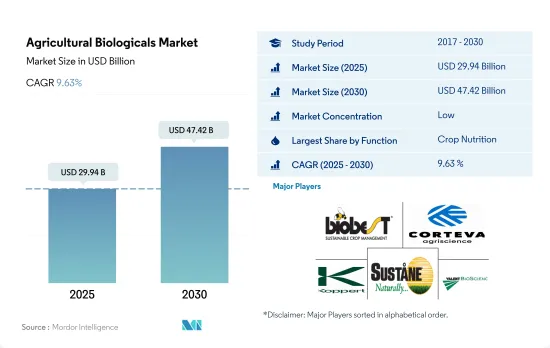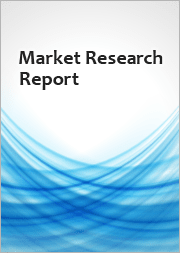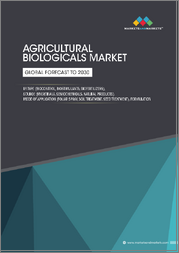
|
시장보고서
상품코드
1686316
농업용 생물제제 : 시장 점유율 분석, 산업 동향 및 통계, 성장 예측(2025-2030년)Agricultural Biologicals - Market Share Analysis, Industry Trends & Statistics, Growth Forecasts (2025 - 2030) |
||||||
농업용 생물제제 시장 규모는 2025년에 299억 4,000만 달러에 달할 것으로 추정됩니다. 2030년에는 474억 2,000만 달러에 이를 것으로 예상되며, 예측 기간 중(2025-2030년) CAGR은 9.63%를 나타낼 것으로 전망됩니다.

- 2022년 세계의 농업용 생물제제 시장에서는 작물 영양 분야가 가장 높은 점유율을 차지하며 금액으로 64.7%, 수량으로 98.1%를 차지했습니다. 유기 비료는 2022년에 작물 영양 시장의 약 58.8%를 차지했는데, 이는 엄청난 가용성과 저렴한 비용 때문입니다.
- 세계의 유기 비료 시장은 2022년에 43.2%를 차지한 밀 기반 비료가 지배적이었습니다. 골분은 주로 작물 생산에 필요한 인을 채우는 데 사용되는 반면 혈분은 주로 작물에 질소를 공급하는 데 사용됩니다.
- 2022년 작물영양 분야에서는 연작작물이 81.3%를 차지하고, 이어 원예 작물이 10.0%, 환금 작물이 8.7%의 점유율을 차지했습니다. 경작 작물이 우세한 것은 재배 면적이 넓기 때문입니다.
- 생물 방제제 분야에서는 거시 미생물이 우세했고, 2022년에는 31억 1,000만 달러를 차지했습니다. 이 높은 점유율은 광범위한 해충을 치료하는 능력 때문입니다. 다른 생물 방제 생물과 비교할 때, 마크로비알은 욕심 많은 포식자입니다.
- 2022년에 포식자는 다양한 해충종과 그 라이프 스테이지를 공격하는 능력에 의해 금액 기준으로 거시 생물 시장의 약 91.0%를 차지했습니다.
- 합성 비료의 유해한 영향에 대한 소비자 지식 증가는 국제적으로나 국내적으로 유기 제품에 대한 수요를 끌어올리고 있습니다. 그 결과 시장은 2023년부터 2029년까지 성장할 것으로 예상됩니다.
- 유럽은 세계 최고의 유기농 작물 생산지이자 유기 제품의 최대 소비지이기도 합니다. 독일과 프랑스는이 지역의 주요 유기농 작물 생산국 중 하나이며,이 지역 시장의 유기농 제품 소비에서 가장 높은 비율을 차지합니다. 전반적인 유기농 작물 재배 면적 증가로 인해 지역 시장은 약 22.9% 확대되고 있습니다. 시장은 2023년부터 2029년 사이에 CAGR 8.5%를 나타낼 것으로 전망되고 2029년에는 141억 1,000만 달러에 이를 것으로 예상됩니다.
- 아시아태평양은 유기농 제품의 생산이 활발해 시장 규모에서는 2위입니다. 중국과 인도는이 지역의 주요 유기농 작물 생산자이자이 지역에서 가장 큰 유기농 제품 소비자입니다. 이 지역의 유기농업 면적은 2017년에서 2021년에 걸쳐 크게 증가했으며, 2017년 490만 헥타르에서 2021년에는 690만 헥타르로 확대되었습니다.
- 북미는 2022년 세계 바이오 비료 시장액의 34.5%를 차지했습니다. 이 지역의 유기농 작물 재배 면적은 2017년 140만 헥타르에서 2021년 160만 헥타르로 13.5% 증가했습니다. 이 지역의 유기농 식품에 대한 수요는 급속히 확대되고 있으며, 북미 유기농 식품에 대한 1인당 평균 지출액은 2021년 109.7달러로 평가되었습니다.
- 유기농 작물의 작물 면적이 확대되고 유기 제품과 생물학적 비료 수요가 높아짐에 따라 화학비료의 사용량 전체와 작물 생산 비용이 저하됩니다. 유기농업을 장려하는 정부의 이니셔티브는 2023년부터 2029년 사이에 세계의 농업용 생물제제 시장을 견인해 CAGR 9.4%를 나타낼 것으로 예상됩니다.
세계의 농업용 생물제제 시장 동향
북미와 유럽에서는 의식이 높아지고 정부의 이니셔티브으로 유기농업의 생산량이 과거 최고를 기록하고 있습니다.
- 유기농업은 지속가능한 식량시스템에 크게 공헌하는 것으로 대두되어 세계 187개국에서 실천되고 있습니다. 2021년 기준 세계 유기농지역은 7,230만 ha로 2018년부터 2021년까지 전 지역에서 평균 2.9% 증가했습니다. 유기농경지는 1,440만 ha로, 유기농지 전체의 19.9%를 차지했습니다.
- 유기농업의 가장 강력한 시장은 북미와 유럽으로 세계 유기농 경지의 41.0%를 차지하고 있습니다. 2022년에는 유럽에는 650만ha의 유기 경작지가 있었으며, 이는 유기 경작지 전체의 44.1%에 해당하는 수치였습니다. 북미와 유럽에서 유기 재배되는 가장 중요한 작물은 사과, 딸기, 곡물, 올리브입니다.
- 아시아태평양의 신흥 국가들은 또한 유기농업운동에 참여하며 국내 수요를 충족하는 신선한 유기농산물의 생산과 공급으로 자급자족하고 있습니다. 유기농업의 동향은 아시아태평양에서 기세를 늘리고 있으며, 이 지역에서는 2017년부터 2022년에 걸쳐 유기경지 면적이 18.8% 증가했습니다. 이 지역 정부의 주요 이니셔티브도 유기농 농업의 확대 경향에 중요한 역할을 합니다. 예를 들어 일본의 식량·농업·농촌 기본계획은 2030년까지 유기농가와 유기농지의 수를 3배로 늘리는 것을 목표로 하고 있습니다.
- 유기농업의 성장의 원동력이 되는 것은 토양의 건강을 촉진하고, 환경에 대한 영향을 줄이고, 보다 건강한 식품을 생산하는 등 유기농업의 이점에 대한 의식 증가입니다.
유기농 식품의 1인당 지출은 주로 미국과 독일에서 관찰되지만, 이는 보다 건강하고 지속 가능한 식품에 대한 소비자 수요에 기인합니다.
- 유기농 식품 시장은 지난 몇 년간 현저한 성장을 거두었으며, 세계 매출은 2012년 708억 달러에서 2020년 1,206억 달러에 이르렀습니다. 유기농 식품에 대한 추세는 보다 건강하고 지속가능한 식품 선택을 추구하는 소비자 수요 증가와 전통적인 농업이 환경에 미치는 영향에 대한 의식이 증가하는 등 여러 요인들에 힘입어지고 있습니다. 세계 유기농 식품 시장은 향후 수년간 성장세가 지속될 것으로 예상됩니다.
- 유기농 무역협회가 2021년에 실시한 조사에 따르면 같은 해 유기농 과일 및 채소 매출은 약 4.5% 증가하여 전체 유기농 매출의 15%를 차지했습니다. 유기농 제품에 대한 평균 지출액은 북미가 시장을 독점하고 있으며, 미국 1인당 지출액은 2021년에 186.7달러에 이르렀고, 북미 국가 중 가장 높았습니다. 유럽도 유기농 식품 시장에서 큰 성장이 예상되고 있으며, 2021년 1인당 지출액이 가장 높은 것은 독일에서 75.6달러였습니다.
- 유기농 식품 시장은 소비자의 가처분 소득이 높은 선진국들이 여전히 지배적이지만, 신흥 국가에서도 성장이 예상됩니다. 예를 들어, 아시아태평양에서는 근로자 계급이 증가하고 있으며, 유기농 식품을 입수하기 쉽고 저렴한 가격으로 구입할 수 있게 되어 시장 확대에 기여할 가능성이 있습니다.
농업용 생물제제 산업 개요
농업용 생물제제 시장은 단편화되어 상위 5개사에서 4.05%를 차지하고 있습니다. 이 시장 주요 기업은 다음과 같습니다. Biobest Group NV, Corteva Agriscience, Koppert Biological Systems Inc., Sustane Natural Fertilizer Inc. and Valent Biosciences LLC(알파벳순 정렬).
기타 혜택
- 엑셀 형식 시장 예측(ME) 시트
- 3개월의 애널리스트 서포트
목차
제1장 주요 요약과 주요 조사 결과
제2장 보고서 제안
제3장 소개
- 조사의 전제조건과 시장 정의
- 조사 범위
- 조사 방법
제4장 주요 산업 동향
- 유기 재배 면적
- 1인당 유기농 제품에 대한 지출
- 규제 프레임워크
- 아르헨티나
- 호주
- 브라질
- 캐나다
- 중국
- 이집트
- 프랑스
- 독일
- 인도
- 인도네시아
- 이탈리아
- 일본
- 멕시코
- 네덜란드
- 나이지리아
- 필리핀
- 러시아
- 남아프리카
- 스페인
- 태국
- 터키
- 영국
- 미국
- 베트남
- 밸류체인과 유통채널 분석
제5장 시장 세분화
- 기능
- 작물 영양
- 바이오 비료
- 아조스피릴룸
- 아조토박터
- 균근
- 인산염 가용화 박테리아
- 리조비움
- 기타 바이오 비료
- 생물촉진제
- 아미노산
- 풀빅산
- 휴믹산
- 단백질 가수분해물
- 해조류 추출물
- 기타 생물촉진제
- 유기 비료
- 분뇨
- 식사 기반 비료
- 오일케이크
- 기타 유기질 비료
- 작물 보호
- 생물 방제제
- 거대균
- 미생물
- 생물 살충제
- 바이오 살균제
- 바이오 제초제
- 바이오 살충제
- 기타 바이오 농약
- 작물 영양
- 작물의 유형
- 환금 작물
- 원예 작물
- 경작 작물
- 지역
- 아프리카
- 이집트
- 나이지리아
- 남아프리카
- 기타 아프리카
- 아시아태평양
- 호주
- 중국
- 인도
- 인도네시아
- 일본
- 필리핀
- 태국
- 베트남
- 기타 아시아태평양
- 유럽
- 프랑스
- 독일
- 이탈리아
- 네덜란드
- 러시아
- 스페인
- 터키
- 영국
- 기타 유럽
- 중동
- 이란
- 사우디아라비아
- 기타 중동
- 북미
- 캐나다
- 멕시코
- 미국
- 기타 북미
- 남미
- 아르헨티나
- 브라질
- 기타 남미
- 아프리카
제6장 경쟁 구도
- 주요 전략 동향
- 시장 점유율 분석
- 기업 상황
- 기업 프로파일
- Agriculture Solutions Inc.
- Biobest Group NV
- Bioworks Inc.
- California Organic Fertilizers Inc.
- Cascade Agronomics LLC
- Corteva Agriscience
- Indogulf BioAg LLC(Biotech Division of Indogulf Company)
- Koppert Biological Systems Inc.
- Lallemand Inc.
- Samriddhi Crops India Pvt Ltd
- Sigma Agriscience LLC
- Sustane Natural Fertilizer Inc.
- Symborg Inc.
- The Espoma Company
- Valent Biosciences LLC
제7장 CEO에 대한 주요 전략적 질문
제8장 부록
- 세계의 개요
- 개요
- Five Forces 분석 프레임워크
- 세계의 밸류체인 분석
- 시장 역학(DROs)
- 정보원과 참고문헌
- 도표 일람
- 주요 인사이트
- 데이터 팩
- 용어집
The Agricultural Biologicals Market size is estimated at 29.94 billion USD in 2025, and is expected to reach 47.42 billion USD by 2030, growing at a CAGR of 9.63% during the forecast period (2025-2030).

- The crop nutrition segment held the highest share of the global agricultural biologicals market in 2022, accounting for 64.7% by value and 98.1% by volume. Organic fertilizers accounted for about 58.8% of the crop nutrition market in 2022, owing to their vast availability and inexpensive cost.
- The global organic fertilizer market was dominated by meal-based fertilizers, which accounted for 43.2% in 2022. Bone meal is largely used to meet the phosphorus requirements of crop production, whereas blood meal is mostly used to supply nitrogen in crops.
- Row crops accounted for 81.3% of the crop nutrition segment in 2022, followed by horticultural and cash crops, which held shares of 10.0% and 8.7%, respectively. The dominance of row crops was partly due to their large cultivation area.
- Macrobials dominated the biocontrol agents segment, accounting for USD 3.11 billion in 2022. This high share was due to their ability to control a wide range of pests. When compared to other biocontrol organisms, macrobials are voracious feeders.
- In 2022, predators accounted for about 91.0% of the macrobial market by value due to their ability to attack various pest species and their life stages.
- Consumers' growing knowledge of the detrimental effects of synthetic fertilizers is boosting the demand for organic products both internationally and domestically. As a result, the market is expected to grow between 2023 and 2029.
- The European region is one of the world's major producers of organic crops and the largest consumer of organic products. Germany and France are some of the major organic crop producers in the region, and they account for the highest organic product consumption in the regional market. Due to the rise in the overall organic crop area, the regional market has expanded by about 22.9%. The market is expected to grow by a CAGR of 8.5% between 2023 and 2029, reaching USD 14.11 billion by 2029.
- The Asia-Pacific region is a large producer of organic products, ranking second in terms of market value. China and India are the region's leading organic crop producers and the region's largest organic product consumers as well. The region's organic agricultural area increased significantly from 2017 to 2021, growing from 4.9 million hectares in 2017 to 6.9 million hectares in 2021.
- North America accounted for 34.5% of the global biofertilizers market value in 2022. The area under cultivation of organic crops in the region increased by 13.5% from 1.4 million hectares in 2017 to 1.6 million hectares in 2021. The demand for organic food in the region is growing rapidly, with an average per capita spending on organic food products in North America valued at USD 109.7 in 2021.
- The expanding organic crop areas and the rising demand for organic products and biological fertilizers lower the overall chemical fertilizer usage and crop production costs. The governments' efforts to encourage organic farming are expected to drive the global agricultural biologicals market between 2023 and 2029, registering a CAGR of 9.4%.
Global Agricultural Biologicals Market Trends
Organic production is at an all-time high in North America and Europe, due to the increasing awareness and Government initiatives.
- Organic agriculture has emerged as a significant contributor to sustainable food systems, with 187 countries practicing it globally. As of 2021, there was 72.3 million ha of organic agricultural land worldwide, with an average increase of 2.9% across all regions from 2018 to 2021. Organic arable land accounted for 14.4 million ha, representing 19.9% of the total organic agricultural land.
- The strongest markets for organic farming are North America and Europe, accounting for 41.0% of the global organic arable land. In 2022, Europe had 6.5 million ha of organic arable land, equivalent to 44.1% of the overall organic arable agricultural area. The most significant crops grown organically in North America and Europe are apples, strawberries, cereals, and olives.
- Developing countries in Asia-Pacific are also joining the organic agriculture movement and becoming self-sufficient in producing and providing fresh organic produce to meet their domestic demand. The trend of organic farming is gaining momentum in Asia-Pacific, with the region recording an 18.8% increase in organic arable land from 2017 to 2022. The major initiatives by governments in the region also play a vital role in the growing trend of organic farming. For example, Japan's Basic Plan for Food, Agriculture, and Rural Areas aims to triple the number of organic farmers and lands by 2030.
- The growth of organic agriculture is driven by the rising awareness of the benefits of organic farming, such as promoting soil health, reducing environmental impacts, and producing healthier food.
Per capita spending of organic food majorly observed in United States and Germany, attributed to the consumer demand for healthier and sustainable food
- The organic food market experienced significant growth in the past few years, with global sales reaching USD 120.6 billion in 2020, up from USD 70.8 billion in 2012. The trend toward organic food is being driven by several factors, such as increasing consumer demand for healthier, more sustainable food options and a growing awareness of the environmental impact of conventional agriculture. The global organic food market is expected to continue its growth trend over the coming years.
- According to a survey conducted by the Organic Trade Association in 2021, sales of organic fruits and vegetables increased by around 4.5% in the same year, accounting for 15% of the overall organic sales. North America dominates the market in terms of average spending on organic products, with per capita spending in the United States reaching USD 186.7 in 2021, the highest among all North American countries. Europe is also expected to experience significant growth in the organic food market, with Germany accounting for the highest per capita spending of USD 75.6 in 2021.
- While the organic food market is still dominated by developed countries with high consumer disposable incomes, it is also expected to grow in developing nations. For example, the increasing number of working-class people in the Asia-Pacific region may contribute to the market's expansion due to the growing availability and affordability of organic food products.
Agricultural Biologicals Industry Overview
The Agricultural Biologicals Market is fragmented, with the top five companies occupying 4.05%. The major players in this market are Biobest Group NV, Corteva Agriscience, Koppert Biological Systems Inc., Sustane Natural Fertilizer Inc. and Valent Biosciences LLC (sorted alphabetically).
Additional Benefits:
- The market estimate (ME) sheet in Excel format
- 3 months of analyst support
TABLE OF CONTENTS
1 EXECUTIVE SUMMARY & KEY FINDINGS
2 REPORT OFFERS
3 INTRODUCTION
- 3.1 Study Assumptions & Market Definition
- 3.2 Scope of the Study
- 3.3 Research Methodology
4 KEY INDUSTRY TRENDS
- 4.1 Area Under Organic Cultivation
- 4.2 Per Capita Spending On Organic Products
- 4.3 Regulatory Framework
- 4.3.1 Argentina
- 4.3.2 Australia
- 4.3.3 Brazil
- 4.3.4 Canada
- 4.3.5 China
- 4.3.6 Egypt
- 4.3.7 France
- 4.3.8 Germany
- 4.3.9 India
- 4.3.10 Indonesia
- 4.3.11 Italy
- 4.3.12 Japan
- 4.3.13 Mexico
- 4.3.14 Netherlands
- 4.3.15 Nigeria
- 4.3.16 Philippines
- 4.3.17 Russia
- 4.3.18 South Africa
- 4.3.19 Spain
- 4.3.20 Thailand
- 4.3.21 Turkey
- 4.3.22 United Kingdom
- 4.3.23 United States
- 4.3.24 Vietnam
- 4.4 Value Chain & Distribution Channel Analysis
5 MARKET SEGMENTATION (includes market size in Value in USD and Volume, Forecasts up to 2030 and analysis of growth prospects)
- 5.1 Function
- 5.1.1 Crop Nutrition
- 5.1.1.1 Biofertilizer
- 5.1.1.1.1 Azospirillum
- 5.1.1.1.2 Azotobacter
- 5.1.1.1.3 Mycorrhiza
- 5.1.1.1.4 Phosphate Solubilizing Bacteria
- 5.1.1.1.5 Rhizobium
- 5.1.1.1.6 Other Biofertilizers
- 5.1.1.2 Biostimulants
- 5.1.1.2.1 Amino Acids
- 5.1.1.2.2 Fulvic Acid
- 5.1.1.2.3 Humic Acid
- 5.1.1.2.4 Protein Hydrolysates
- 5.1.1.2.5 Seaweed Extracts
- 5.1.1.2.6 Other Biostimulants
- 5.1.1.3 Organic Fertilizer
- 5.1.1.3.1 Manure
- 5.1.1.3.2 Meal Based Fertilizers
- 5.1.1.3.3 Oilcakes
- 5.1.1.3.4 Other Organic Fertilizers
- 5.1.2 Crop Protection
- 5.1.2.1 Biocontrol Agents
- 5.1.2.1.1 Macrobials
- 5.1.2.1.2 Microbials
- 5.1.2.2 Biopesticides
- 5.1.2.2.1 Biofungicides
- 5.1.2.2.2 Bioherbicides
- 5.1.2.2.3 Bioinsecticides
- 5.1.2.2.4 Other Biopesticides
- 5.1.1 Crop Nutrition
- 5.2 Crop Type
- 5.2.1 Cash Crops
- 5.2.2 Horticultural Crops
- 5.2.3 Row Crops
- 5.3 Region
- 5.3.1 Africa
- 5.3.1.1 Egypt
- 5.3.1.2 Nigeria
- 5.3.1.3 South Africa
- 5.3.1.4 Rest of Africa
- 5.3.2 Asia-Pacific
- 5.3.2.1 Australia
- 5.3.2.2 China
- 5.3.2.3 India
- 5.3.2.4 Indonesia
- 5.3.2.5 Japan
- 5.3.2.6 Philippines
- 5.3.2.7 Thailand
- 5.3.2.8 Vietnam
- 5.3.2.9 Rest of Asia-Pacific
- 5.3.3 Europe
- 5.3.3.1 France
- 5.3.3.2 Germany
- 5.3.3.3 Italy
- 5.3.3.4 Netherlands
- 5.3.3.5 Russia
- 5.3.3.6 Spain
- 5.3.3.7 Turkey
- 5.3.3.8 United Kingdom
- 5.3.3.9 Rest of Europe
- 5.3.4 Middle East
- 5.3.4.1 Iran
- 5.3.4.2 Saudi Arabia
- 5.3.4.3 Rest of Middle East
- 5.3.5 North America
- 5.3.5.1 Canada
- 5.3.5.2 Mexico
- 5.3.5.3 United States
- 5.3.5.4 Rest of North America
- 5.3.6 South America
- 5.3.6.1 Argentina
- 5.3.6.2 Brazil
- 5.3.6.3 Rest of South America
- 5.3.1 Africa
6 COMPETITIVE LANDSCAPE
- 6.1 Key Strategic Moves
- 6.2 Market Share Analysis
- 6.3 Company Landscape
- 6.4 Company Profiles (includes Global Level Overview, Market Level Overview, Core Business Segments, Financials, Headcount, Key Information, Market Rank, Market Share, Products and Services, and Analysis of Recent Developments).
- 6.4.1 Agriculture Solutions Inc.
- 6.4.2 Biobest Group NV
- 6.4.3 Bioworks Inc.
- 6.4.4 California Organic Fertilizers Inc.
- 6.4.5 Cascade Agronomics LLC
- 6.4.6 Corteva Agriscience
- 6.4.7 Indogulf BioAg LLC (Biotech Division of Indogulf Company)
- 6.4.8 Koppert Biological Systems Inc.
- 6.4.9 Lallemand Inc.
- 6.4.10 Samriddhi Crops India Pvt Ltd
- 6.4.11 Sigma Agriscience LLC
- 6.4.12 Sustane Natural Fertilizer Inc.
- 6.4.13 Symborg Inc.
- 6.4.14 The Espoma Company
- 6.4.15 Valent Biosciences LLC
7 KEY STRATEGIC QUESTIONS FOR AGRICULTURAL BIOLOGICALS CEOS
8 APPENDIX
- 8.1 Global Overview
- 8.1.1 Overview
- 8.1.2 Porter's Five Forces Framework
- 8.1.3 Global Value Chain Analysis
- 8.1.4 Market Dynamics (DROs)
- 8.2 Sources & References
- 8.3 List of Tables & Figures
- 8.4 Primary Insights
- 8.5 Data Pack
- 8.6 Glossary of Terms



















